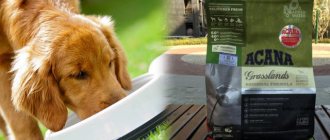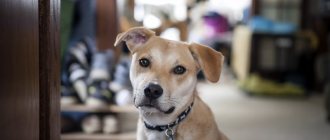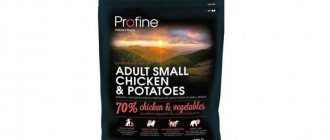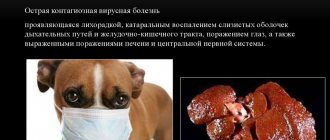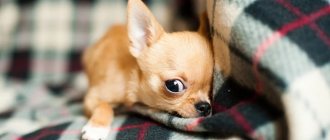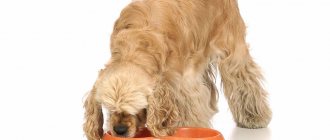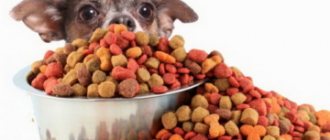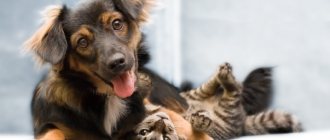Factors influencing diet
The body's need for more or less food directly depends on what physiological changes occur in it throughout life.
If you follow your pet's lead and give him food every time he asks, there is a risk of overeating, and as a result, obesity. Therefore, it is important for the owner to create a feeding schedule and monitor the pet’s weight. The serving size should always be the same and appropriate to the needs of the cat depending on its weight, age, breed, activity.
- We want to eat?..
Attention! If your cat regularly leaves uneaten food, the portion size should be reduced.
After 15-20 minutes have passed after the animal is full, the bowl of food is removed and the remaining food is disposed of. The possibility of a cat being poisoned by a spoiled product must not be allowed. The dishes are washed and dried, preparing for the next feeding. There should always be a bowl of clean water near the food bowl, which is changed daily.
It is important to monitor the amount of water you drink, especially if your pet eats ready-made dry food. Often cats prefer to drink water from household utensils: buckets or basins. It is necessary to ensure that the water in such containers is always fresh and clean. Refusal to drink or excessive thirst is a reason to contact a veterinarian. Perhaps the food is not suitable for the animal, or it is possible that this is a symptom of a disease.
If a cat quickly absorbs food, but does not get enough, constantly begs for food, and does not gain weight, it is necessary to examine it for the presence of parasites.
In summer, a cat's appetite worsens due to the heat - the pet spends most of the day dozing, drinking water, eating little by little early in the morning and towards night. And in the fall, the predator’s appetite increases, because by winter it needs to gain weight and restore its coat.
A cat's health also affects its appetite. The need to take medications, their possible side effects, and the nature of the disease are factors that reduce a cat’s interest in food.
For feeding and drinking, it is best to use wide cups with low sides. If you are keeping several pets, dishes with food should be installed at different levels or in different rooms so that the animals eat calmly, do not rush and do not try to take food from each other.
How many times a day should you feed a kitten?
The needs of a kitten’s growing body and its physiology are significantly different from the needs of an adult animal. Consequently, the approach to feeding babies is different.
It is necessary to follow the feeding regime
The kitten must be fed, strictly observing the time interval between meals and dosage:
- From 0 to 2 months, a baby, left without a mother for some reason, is fed around the clock, every 3 hours.
- From 2 to 3 months, complementary feeding begins. The baby is fed every 4 hours, regardless of the time of day.
- From 3 to 6 months of age, the animal should receive food 3-4 times a day, excluding feeding at night.
- From 6 months to 1 year – 2-3 times a day.
- Over 1 year – 2 times a day.
In the morning, you can leave double the amount of dry food in the bowl if the owner is at work until the evening. A healthy kitten will not eat more than it needs. But it is not recommended to keep food freely available for kittens and cats prone to overeating.
For active growth and harmonious development of a kitten, for every 100 g of weight, the following is required daily:
- 30 ml of formula - for 1 feeding until the 4th day from birth;
- 40 ml – from 5 to 14 days;
- 45 ml – from 14 to 21 days;
- 50 ml – from the 3rd week.
How much should a cat eat per day?
To keep your pet healthy and alert, its diet must be nutritious and balanced. It is the nutritional value of the product that determines how many times a day you need to feed your cat. The amount of food eaten during the day should be no more than 7.5% of the animal’s weight.
The dosage of ready-made food is indicated on the packaging, and with natural feeding, the cat needs to eat up to 150 g of meat or fish per day, which is 50% of the daily protein intake. The natural diet is supplemented with fermented milk products, cereal porridges, seasonal vegetables, vitamins and mineral nutritional supplements. Meal frequency – 2 times a day.
-Can I have a piece?..
The diet of a pregnant cat should have an increased energy value: contain more vitamins and minerals, but not increase the calorie content of the product. Increase the frequency of feedings up to 4-5 times, maintaining the usual serving size. A nursing cat is also provided with frequent feeding, while increasing the volume and calorie content of food.
Note! It is better to prepare the diet for a pregnant or lactating cat after consultation with a veterinarian.
Good puppy feeding: basic points
When choosing the type of dog food (dry food or natural food), follow the rule - do not overfeed! Overeating can have serious consequences. It’s not worth growing your pet’s stomach to a large size; overfeeding will lead to poor health, joint problems, which is especially important for large breed dogs), and diseases of the internal organs.
When can you feed puppies? Before bedtime, if the dog is hungry. Offer your pet milk porridge, pamper it with meat, but do not make the ritual daily.
Feeding the puppy natural food
Many owners choose how to feed their dogs natural products. The reasons for choosing are as follows:
- natural food is cheaper than buying ready-made food;
- natural food gives confidence in the quality of food.
There are also a lot of disadvantages to feeding “human” food: you have to often go to the store and prepare food, because during the growth period the animal eats a lot.
The main motto is “Only natural”, isn’t the prospect of standing near the stove for a long time scary? We recommend paying attention to the freshness of the products. Meat that tastes good at a low price will play a cruel joke on the health of an eared baby. Poisoning from low-quality products is not uncommon. Remember that a puppy is a small child, so it is important to take food responsibly.
Second rule: you cannot feed your dog from the table! Signature aromatic borscht, seasoned with sour cream, cabbage rolls prepared according to a family recipe will appeal to people, but not to the puppy, and will cause problems with his well-being!
What can you feed your little friend?
1) Milk
A puppy's diet up to 4 months includes milk. This product provides vital elements for the growth and development of a foolish baby. Offer it raw and cook milk porridge. Not every milk will do. Choose goat, you can’t go wrong - there are rarely allergies to it, and it is easier to accept by the body. Having trouble finding a goat? You can give cow's milk, but dilute it with water to avoid intestinal upset.
Closer to six months, the amount of milk is reduced and gradually eliminated, replacing it with fermented milk products.
2) Dairy products
Proper feeding of puppies consists of many factors, including fermented milk. Good digestion and enrichment of the body with calcium are a wonderful reason to buy your pet cottage cheese, kefir, and low-fat sour cream. Whey is one of the most useful products, containing a huge amount of useful substances. According to the degree of usefulness, hard cheeses are distinguished, which are easy to use as a reward during training.
3) Meat
It must be present in the daily menu, at least 40% of the total diet. You can give raw, frozen, boiled, scalded meat. The priority is still given to raw meat, because the predator is being raised. What species can be included in a puppy's diet?
- skinless chicken;
- turkey;
- veal;
- beef;
- horsemeat;
- offal (cooked, raw).
The meat is given, cut into cubes, but not minced.
4) Fish and seafood
Offer it to your puppy twice a week. Give preference to sea fish (river fish is often hazardous to health): squid, shrimp, mackerel, hake, pollock. Do not mix with meat feedings.
5) Vegetables
Teach your baby to vegetables: they contain many vitamins. Mix with cottage cheese, porridge, grind on a fine grater, serve as a puree or simmer - and you have delicious dishes that are easily digestible. Pumpkin, carrots, zucchini, beets, and greens (onions, parsley, spinach) are useful.
6) Berries, fruits
Undoubtedly, they are useful, so feel free to include them in the diet, especially if your dog likes to crunch on an apple. Beware of fruits with pits containing prussic acid. It is not advisable to give bananas; the fruit will cause rapid weight gain. Grapes and currants cause bloating and the accumulation of harmful substances in the body.
7) Cereals
Let's make a reservation right away: porridge for puppies is excluded as the main element of the menu. Cereals are good for digestion, but you should not feed a growing dog only cereals. And as an addition to a dairy-meat diet, they are ideal.
What kind of cereals will your furry baby like?
- semolina;
- buckwheat;
- rice;
- oatmeal
When adding a certain type of porridge to the menu, monitor the puppy’s condition; if there is an intestinal disorder, exclude this type for a while.
 Eggs
Eggs
They serve as an excellent source of protein; it is recommended to include egg yolk in the diet 2 times a week. The dog will like omelettes and eggs in their pure form. Quail eggs are ideal.
Feeding puppies food
How to properly feed a puppy with dry food is something every owner will think about when they decide to make food the main way of feeding their little four-legged friend. Many people worry that dry food contains few important substances for harmonious growth and development. Manufacturers year after year develop food that can satisfy a dog’s hunger, provide the animal with all the vital vitamins and minerals, and give the animal smooth, shiny fur and strong teeth. Dry food is properly balanced, food is easy to give, following the instructions for the daily intake.
How to properly feed a puppy?
It is recommended to give the baby food in a soaked form. Thirty minutes before the intended feeding, the granules are poured with warm water to swell. The use of broths for this purpose is excluded.
How many times should you give your puppy dry food per day? Follow the recommendations on the packaging. The dose should not be exceeded: there is a high risk of overdosing on nutrients. It is important for the owner to know that dry food is very high in calories and differs from natural food, so the dog must be given granules strictly according to the instructions.
There are situations that require switching a puppy from natural food to commercial food. This should be done gradually, without sudden jumps, consult your veterinarian first.
The Zoomix store offers dry food of existing classes: from economy options to super premium. We advise you to look for the following brands:
- Hill's;
- Royal Canin;
- Eagle Pack;
- Purina Proplan;
- Genesis;
- Diamond.
- Popular foods
- New
- Stock
NAW grain-free food for large breed puppies with turkey, duck and vegetables
NAW grain-free food for large breed puppies with turkey, duck and vegetables
Price: from 3117
Dry puppy food PURINA PRO PLAN Small & Mini Puppy
Dry food for puppies PURINA PRO PLAN Small & Mini Puppy Complete dry food for puppies of small and toy breeds Purina® PRO PLAN® Small & Mini Puppy with…
Price: from 380
GO grain-free food for puppies and dogs with sensitive digestion with turkey
GO grain-free food for puppies and dogs with sensitive digestion with turkey
Price: from 1340
Dry food GO (Go) for puppies and dogs with salmon and oatmeal
Dry food GO (Go) for puppies and dogs with salmon and oatmeal
Price: from 1065
Royal Canin Skin&Coat Formula Complete food for adult cats with hypersensitive skin, sauce
Royal Canin Skin&Coat Formula Complete food for adult cats with hypersensitive skin, sauce Canned complete food for adult cats over 12 months old, with hypersensitive skin/coat Recommended…
Price: from 73
Canned food Four-legged gourmet GOLDEN LINE Chicken with veal in jelly for kittens
Canned food Four-legged gourmet GOLDEN LINE Chicken with veal in jelly for kittens Ingredients: chicken meat, veal, chicken fat, rice, taurine, brewer's yeast, fish oil, seaweed, yucca schedigera, jelly, water...
Price: from 68
NAW grain-free food for small breed puppies with turkey, duck and vegetables
NAW grain-free food for small breed puppies with turkey, duck and vegetables
Price: from 1806
AquaEL Filter UNIFILTER UV 750 (200-300l)
AquaEL Filter UNIFILTER UV 750 (200-300l) • LED UV diodes guarantee adequate water sterilization • Two independent filter sponges • Two…
Price: from 2544
GREENHEART-PREMIUMS NORMAL USE MEAL For dogs of all breeds with normal and low activity levels
GREENHEART-PREMIUMS NORMAL USE MEAL For dogs of all breeds with normal and low activity levels
Price: from 1100
Go Dog Food with Turkey and Salmon
Go Dog Food with Turkey and Salmon
Price: from 323
LECHAT. Canned cat food with chicken and turkey (100g)
LECHAT. Canned cat food with chicken and turkey (100g) Content of main nutrients: Protein 9.00% Fat 7.00% Fiber 0.50% Moisture 79.00% Ingredients: Meat and meat products (chicken - …
Price: from 32
8in1 Delights Bone S/11cm
8in1 Delights Bone S/11cm Chewy bone for dogs with chicken meat, wrapped in rawhide Chewy bones with chicken meat are a favorite treat…
Price: from 182
ALL PUPPY FOOD
Feeding standards
The amount of food per meal depends on its type and type of feeding. Veterinarians recommend keeping domestic cats on a natural diet, regularly using vitamin and mineral supplements, and following a two-time feeding regimen (morning and evening).
An adult healthy animal should be provided with at least 10 g of protein, 2 g of fat, 1 g of carbohydrates, 1 g of fiber per 1 kg of weight per day. The daily energy value for natural feeding should be at least 40 kcal per 1 kg of weight.
If the owner buys ready-made food for his fluffy dog, he must strictly adhere to the dosage indicated on the packaging. Finished products of different brands differ in the quality of raw materials, preparation technology, and composition. For example, for a healthy adult cat weighing 4 kg, the average amount of dry food per day is 60-70 g, divided into two meals.
Important! Depending on the composition of the feed, its purpose and class, the dosage may differ slightly for animals of the same weight category. The higher the product class, the lower the feed consumption . All ready-made food is completely balanced and nutritious. Premium, super-premium or holistic products undergo numerous quality checks, are safe for animals and are economical.
Super-premium and higher class food is most suitable for the animal
The main parameter by which the required amount of ready-made food per day is determined is the weight of the animal. To ensure full life activity, per 1 kg of adult weight there should be 30-60 g of food containing 60-70 kcal.
Below are tables showing how much dry and wet food a cat needs per day:
How much dry food do you need per day?
| Cat weight, kg | Feeding rates depending on the type of food, g | ||
| Healthy eating | Nutrition for weight loss | For an animal over 7 years old | |
| 2 | 40 | — | 30 |
| 3 | 45 | — | 30 |
| 4 | 60 | — | 40 |
| 5 | 75 | 60 | 60 |
| 6 | 80 | 60 | 60 |
| 8 | 105 | 75 | 90 |
| 10 | 120 | 80 | 105 |
How much wet food do you need per day?
| Cat weight, kg | Wet food only, bag | 1 bag + dry food, g |
| 3 | 2,5 | 25 |
| 4 | 3,5 | 35-40 |
| 5 | 4 | 50-55 |
| 6 | 5 | 60-70 |
As you can see, it is not difficult to determine how many bags of food to give your cat per day. An adult weighing 4-5 kg will need 3-4 packages of wet food or 1 package of wet food and 35-55 g of dry product of the same brand.
3-4 sachets per day
It is recommended to use food from the same manufacturer and never mix natural food with a finished product for cats (especially dry food).
Choosing between industrial and natural products
At 4 weeks of age, supplementary feeding must be introduced into the kitten’s diet. What exactly to feed your baby depends on your dietary preferences. By and large, there are two options; you can start feeding the kitten:
- Natural products.
- Industrial wet food.
We do not even consider the option of mixing natural and industrial feeding, since such feeding for an artificial kitten is guaranteed to lead to: dysbiosis, constipation, diarrhea or indigestion. Regardless of the type of food chosen, it is necessary to maintain a protein diet, maintain the mass fraction of dairy products at least 70% and teach the kitten to drink water.
Features of feeding wet food
Feeding a kitten 1 month of age and older is entirely up to the owner. The baby does not yet have taste preferences, so he willingly eats everything that seems edible.
A kitten considers foods that are edible to be:
- They smell good.
- Contains enough water.
- They have a soft or liquid consistency.
- They have a comfortable temperature (37–38.5 degrees).
When you start supplementing with wet food in the form of a pate, you will meet all the conditions if you preheat the food. If the kitten does not know how to chew, the pate can be diluted with hot water and stirred until it becomes a paste. Pates and wet food pieces can and should be used for supplementary feeding up to six months of age.
Diet
For a pet, diet is a very important factor. It is advisable to feed your cat at the same time, keeping the same interval between meals.
Important! It is prohibited to feed the pet from the owner's table, especially while the family is having dinner. In addition to the fact that this food is simply dangerous for the pet, it will very quickly develop and strengthen this method of receiving treats. It will be very difficult to rid a cat of a bad habit. He will constantly demand food, even when full. This is a direct path to overeating and health problems.
By following a feeding schedule, it is easier to control the amount of food eaten, thereby maintaining your pet’s optimal weight. This is especially important for castrated animals and for cats leading a sedentary lifestyle.
For cats over 7 years old, the frequency of feeding can be reduced to 1 time, because the rate of metabolic reactions in their body slows down.
The owner decides on his own what specific hours to feed his pet. The main thing is that both parties feel comfortable.
Benefits of scheduled feeding:
- Feeding on a schedule disciplines the pet and the owner, who determines how often the cat needs to be fed and keeps the amount of food fed under control.
- The cat's health and digestive system function improves.
- Scheduled feeding reduces the risk of obesity in spayed and neutered animals.
- It is possible to observe the cat's appetite.
- Weaning your cat off begging during the day.
- Helps provide better care for small kittens, elderly and sick individuals.
Consider the treats
If one day you notice that your pet hasn’t finished the food, don’t pour out the full portion. It makes more sense to reduce it as much as remains untouched. Perhaps the cat caught a mouse or ate something from the owner’s table. In this case, even feeding according to the table will be redundant.
For example, your pet weighs 4 kg and eats ACANA Pacifica. The daily feeding rate for him is 60 grams, which contain 245 kilocalories. If a cat receives 50-60 g of chicken or lean beef as a treat, its diet increases by approximately 100 kcal. When such treats are regular, and food is given in full, excess weight will not take long to occur.
Do you like to treat your cat? Consider treats when planning your diet and reduce your daily amount of dry food accordingly. Information about the calorie content of products is always on the packaging.
